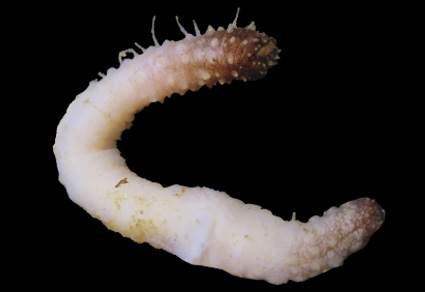Abstract
The present paper describes two often-reported species of Labidodemas as present in Indonesia: L. rugosum (Ludwig, 1875) and L. semperianum Selenka, 1867, and describes a new species to science Labidodemas javaensis sp. nov. from the shallow water of Java Island. The new species is distinguished from its congeners by having (1) most table discs devoid of peripheral holes with rim of the discs very spiny, (2) dorsal papillae and ventral tube feet that always have two types of tables (regular table with crown spines always bifurcate distally and smaller table size with very spiny disc and crown), and (3) the presence of a tri-radiate shape of rods in the dorsal body wall and anal papillae. Nine species are now recognised as valid within the genus Labidodemas, and five of them are found on the Indonesian sea floor. Furthermore, we also observed Cuvierian tubules in some individuals of L. rugosum and L. semperianum. The latter observation supports the argumentation to best-keep Labidodemas at the generic level within Holothuriidae.
References
- BIG (2021) Rapat Koordinasi Data Pulau Sepakati Jumlah Pulau Indonesia 17 Ribu. Berita Geospasial, 1. Available from: https://www.big.go.id/content/berita/rapat-koordinasi-data-pulau-sepakati-jumlah-pulau-indonesia-17-ribu (accessed 1 November 2021)
- Cannon, L.R.G. & Silver, H. (1986) Sea cucumbers of northern Australia. Queensland Museum, Brisbane, 60 pp.
- Cherbonnier, G. (1988) Echinodermes: Holothurides. Faune de Madagascar, 70, 1–292.
- Clark, A.M. & Rowe, F.W.E. (1971) Monograph of shallow water Indo-Pacific Echinoderm. Trustees of British Museum (Natural History), 238 pp.
- Clark, H.L. (1921) The echinoderm fauna of Torres Strait: its composition and its origin. Department of Marine Biology of the Carnegie Institute, Washington, D.C., 223 pp. https://doi.org/10.5962/bhl.title.14613
- Conand, C. (1989) Les holothuries aspidochirotes du lagon de Nouvelle-Caledonie. Biologie, ecologie et exploitation. Institut Francais De Recherche Scientifique Pour Le Developement En Coroperation, Paris, 328 pp.
- Deichmann, E. (1938) Eastern Pacific Expeditions of the New Yorl Zoological Society, XVI. Holothurians from the Western Coasts of Lower California and Central America, and from the Galápagos Islands. Zoologica: Scientific Contributions of the New York Zoological Society, 23, 361–387. https://doi.org/10.5962/p.184698
- Deichmann, E. (1958) The Holothurioidea collected by the Velero III and IV during the years 1932 to 1954. Part II. Aspidochirota. Allan Hancock Pacific Expeditions, 11, 249–349.
- Endean, R. (1957) The biogeography of Queensland’s shallow-water Echinoderm fauna (excluding Crinoidea) with a rearrangement of the faunistic province of tropical Australia. Australian Journal of Marine & Freshwater Research, 8, 233–273. https://doi.org/10.1071/MF9570233
- James, D.B. (1981) Studies on Indian Echinoderms 7. On a new Family Labidodematidae (Holothurioidea: Aspidochirotida) with a detailed description of Labidodemas rugosum (Ludwig) from the Andamans. Journal of the Marine Biological Association of India, 23, 82–85.
- Jangoux, M., De Ridder, C., Massin, C. & Darsono, P. (1989) The holothuroids, echinoids and asteroids (echinodermata) collected by the Snellius-II expedition. Netherlands Journal of Sea Research, 23, 161–170. https://doi.org/10.1016/0077-7579(89)90010-0
- Kerr, A.M. (1994) Shallow-water Holothuroids (Echinodermata) of Kosrae, Eastern Caroline Islands. Pacific Science, 48, 161–174.
- Lane, D.J.W., Marsh, L.M., VandenSpiegel, D. & Rowe, F.W.E. (2000) Echinoderm Fauna of the South China Sea : an Inventory and Analysis of Distribution Patterns. Raffles Bulletin of Zoology, 48, 459–493.
- Liao, Y. (1975) The echinoderm of Xisha Island. I. Holothurioidea, Guangdong Province, China. Studia Marina Sinica, 10, 199–230.
- Liao, Y. (1984) The Aspidochirote holothurians of China. Studia Marina Sinica, 23, 221–247.
- Ludwig, H. (1875) Beitrage zur Kenntniss der Holothurien. Arbeiten aus dem Zoologisch-Zootomischen Institut in Würzburg, 2, 77–118.
- Marsh, L.M. (1994) Echinoderms of the Cocos (Keeling) Islands. Atoll Research Bulletin, 411, 1–12. https://doi.org/10.5479/si.00775630.411.1
- Massin, C. (1999) Reef-dwelling Holothuroidea (Echinodermata) of the Spermonde Archipelago (South-West Sulawesi, Indonesia). Zoologische verhandelingen. Vol. 329. National Museum of Natural History, Leiden, 144 pp.
- Massin, C., Samyn, Y. & Thandar, A.S. (2004) The genus Labidodemas (Holothuroidea: Aspidochirotida) revisited, with description of three new species and with re-positioning of Holothuria (Irenothuria) maccullochi Deichmann, 1958. Journal of Natural History, 38, 1811–1847. https://doi.org/10.1080/0022293031000156268
- Panning, A. (1934b) Die Gattung Holothuria. 3. Teil. Mitteilungen aus dem Zoologichen Staatsinstitur und Zoologischen Museum in Hamburg, 1934, 65–84.
- Pearson, J. (1913) Notes on the Holothurioidea of the Indian Ocean. Spolia Zeylandica, 9, 49–101. https://doi.org/10.5962/bhl.part.7317
- Purwati, P. & Wirawati, I. (2011) Holothuriidae (Echinodermata, Holothuroidea, Aspidochirotida) Perairan Dangkal Lombok Barat Bagian II. Genus Actinopyga, Bohadschia, Pearsonothuria, Labidodemas. Jurnal Oseanologi, 3(1/2), 1–10.
- Rowe, F.W.E. & Doty, J.E. (1977) The shallow-water holothurians of Guam. Micronesica, 13, 217–250.
- Rowe, F.W.E. & Gates, J. (1995) Echinodermata. In: Wells, A. (Ed.), Zoological Catalogue of Australia. Vol. 3. CSIRO, Melbourne, pp. 1–510.
- Rowe, F.W.E. (1969) A Review of The Family Holothuriidae. (Holothurioidea: Aspidochirotida). Bulletin of the British Museum (Natural History), Zoology, 18, 117–170. https://doi.org/10.5962/bhl.part.18419
- Rowe, F.W.E. (1983) A collection of Holothurians in the Leiden Museum from the East Indies and new Guinea, with the description of a new species of Protankyra (Holothurioidea: Synaptidae) from Java. Zoologische Mededelingen, 57, 149–164.
- Samyn, Y., Appeltans, W. & Kerr, A.M. (2005) Phylogeny of Labidodemas and the Holothuriidae (Holothuroidea: Aspidochirotida) as inferred from morphology. Zoological Journal of the Linnean Society, 144, 103–120. https://doi.org/10.1111/j.1096-3642.2005.00158.x
- Selenka, E. (1867) Beitrage zur anatomie und systematik der holothurien. Zeitschrift für wissenschaftliche Zoologie, 17 (2), 291–374.


